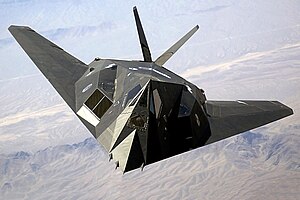| F-117 Nighthawk | |
|---|---|
 F-117 flying over mountains in Nevada in 2002 | |
| General information | |
| Type | Stealth attack aircraft[1] |
| National origin | United States |
| Manufacturer | Lockheed Corporation |
| Status | Used as training aircraft as of 2024 |
| Primary user | United States Air Force |
| Number built | 64 (5 YF-117As, 59 F-117As) |
| History | |
| Introduction date | October 1983[2] |
| First flight | June 18, 1981 |
| Developed from | Lockheed Have Blue |
The Lockheed F-117 Nighthawk is a retired American single-seat, subsonic twin-engine stealth attack aircraft developed by Lockheed's secretive Skunk Works division and operated by the United States Air Force (USAF). It was the first operational aircraft to be designed with stealth technology.
Work on what would become the F-117 commenced in the 1970s as a means of countering increasingly sophisticated Soviet surface-to-air missiles (SAMs). During 1976, the Defense Advanced Research Projects Agency (DARPA) issued Lockheed with a contract to produce the Have Blue technology demonstrator, the test data from which validated the concept. On 1 November 1978, it was decided to proceed with the F-117 development program. A total of five prototypes would be produced; the first of which performed its maiden flight in 1981 at Groom Lake, Nevada. The first production F-117 was delivered in 1982, and its initial operating capability was achieved in October 1983. All aircraft were initially based at Tonopah Test Range Airport, Nevada.
The aircraft's faceted shape (made from two-dimensional flat surfaces) heavily contributes to its relatively low radar cross-section of about 0.001 m2 (0.0108 sq ft). To minimize its infrared signature, it has a non-circular tail pipe that mixes hot exhaust with cool ambient air and lacks afterburners; it is also restricted to subsonic speeds as breaking the sound barrier would produce an obvious sonic boom that would increase both its acoustic and infrared footprints. While its performance in air combat maneuvering was less than that of most contemporary fighters, it was strictly an attack aircraft despite being commonly referred to as the "Stealth Fighter". For this reason, it is equipped with integrated sophisticated digital navigation and attack systems, targeting being achieved via a thermal imaging infrared system and a laser rangefinder/laser designator. It is aerodynamically unstable in all three aircraft principal axes and thus requires constant flight corrections via a fly-by-wire (FBW) flight system to maintain controlled flight.
Even in the years following its entry to service, the F-117 was a black project, its existence being denied by USAF officials. On 10 November 1988, the F-117 was publicly acknowledged for the first time. Its first combat mission was flown during the United States invasion of Panama in 1989. The last of 59 production F-117s were delivered on 3 July 1990. The F-117 was widely publicized for its role in the Gulf War of 1991, having flown approximately 1,300 sorties and scored direct hits on what the US military described as 1,600 high-value targets in Iraq. F-117s also participated in the conflict in Yugoslavia, during which one was shot down by a surface-to-air missile (SAM) in 1999. It was also active during Operation Enduring Freedom in 2001 and Operation Iraqi Freedom in 2003. The USAF retired the F-117 in 2008, primarily due to the fielding of the F-22 Raptor.[3] Despite the type's official retirement, a portion of the fleet has been kept in airworthy condition, and F-117s have been observed flying since being retired from combat.[4]
- ^ Cite error: The named reference
eden_p240was invoked but never defined (see the help page). - ^ Cite error: The named reference
Nat_Museum_factshtwas invoked but never defined (see the help page). - ^ Cite error: The named reference
Miller 44was invoked but never defined (see the help page). - ^ "A Rare F-117A Stealth Fighter Flies Over 'Star Wars Canyon". Popular Mechanics. 19 March 2020.